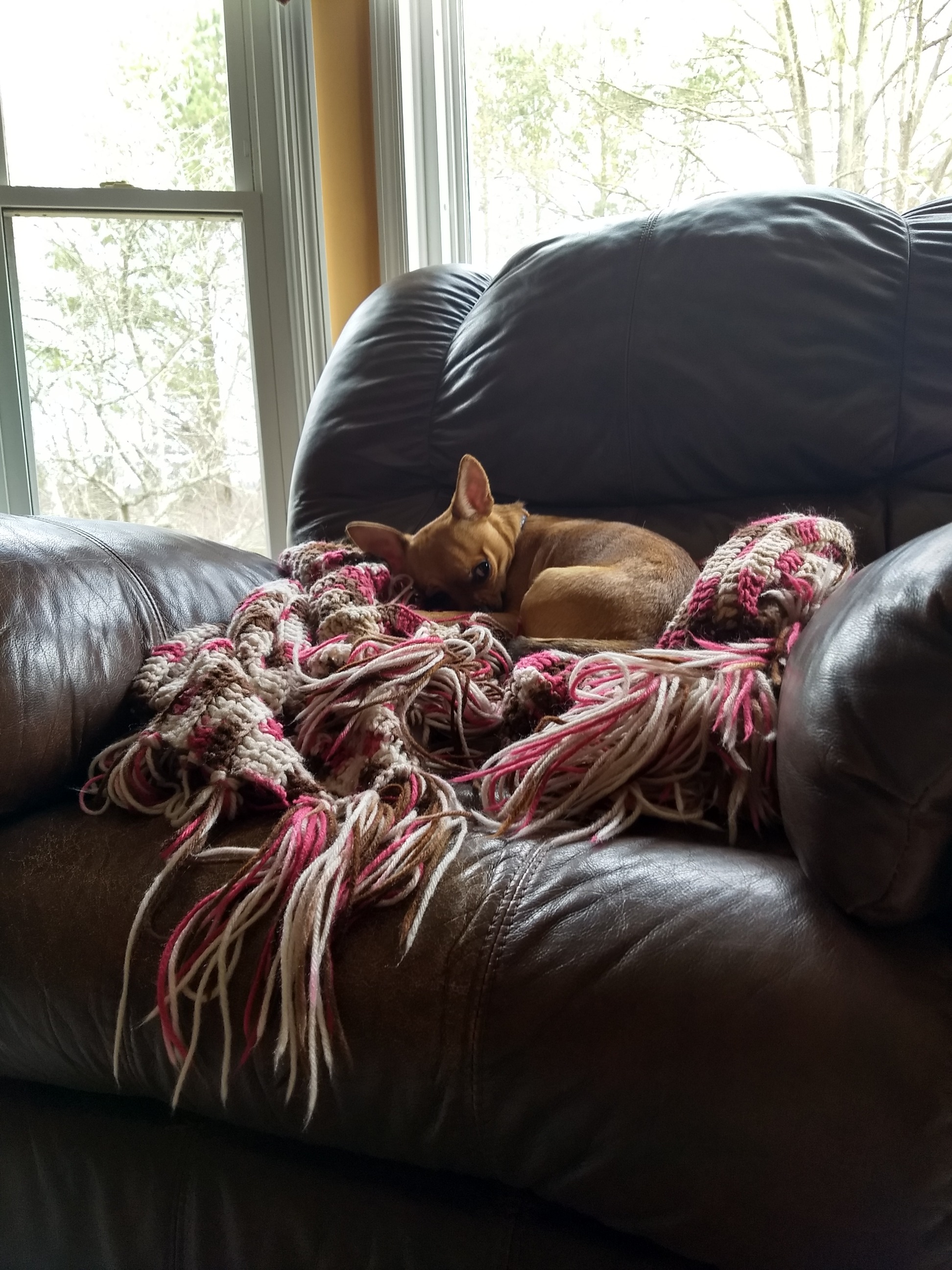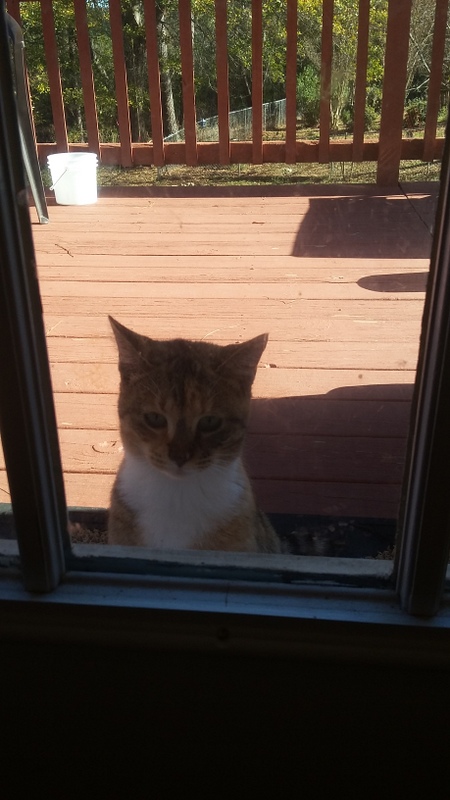Hello! Today I am pleased to unveil a short story that I have been working on for a long time. Between studying, writing, and editing three times, this has been a lot of work. But now I can say that I have successfully completed a short story that I can be proud of, so all of that editing was worth it. I hope you enjoy this story as much as I enjoyed writing it! Anyway, without further ado, I present to you…
My Heart is in the Mountains
One summer evening in 1837, as the sun was shining brightly through the trees of the Appalachian foothills, a Cherokee girl named Ama sat with her family on the grass beside their cozy home made of chestnut logs. Ama, her grandparents, her parents, her two sisters Tallalla and Ahyoka, and her brother William were all enjoying dinner together. Ama’s baby sister Jane was sleeping in a wrap on Mother’s back. As they ate, they all listened attentively to Ama’s grandfather who spoke somberly in their native tongue of how the white men had taken and settled more than half of the Cherokee land, had sold the remaining portion in the Cherokee Land Lottery, and had forced their family to move from their home near the Chattahoochee River to the home they had now.
“Then, two summers ago, some of our own tribesmen signed a treaty to have us removed from our homeland forever. I am certain it will happen soon,” he said with disappointment in his eyes. “Nothing has been the same since the white men came.” Ama looked up at her wrinkled yet strong grandfather. She could not help but agree with him.
“We must forgive the white men, though,” Ama’s grandmother reminded wisely, “for that is what God would want us to do.” Everything was quiet for a few minutes as they all thought about forgiveness. Ama and her family were Christians, having learned about their God and Savior at one of the many missionary schools that had been built throughout the Cherokee land. “It was the white men who told us about God,” Grandmother said thoughtfully.
“That is true,” Grandfather said firmly, his face as stern as always. “But I wish that the white men would act like Christians and not just say that they are Christians.” Ama thought about that. Often the white men did not act like Christians around the natives. The white men even called the Christian Cherokees “savages.”
“Are they really going to make us go to Indian Territory, Grandfather?” William asked, looking up from his bowl of soup.
“They will. Just wait,” Grandfather said assuredly. Ama’s eyes grew big at those words. She could not imagine having to leave her homeland, the land that had belonged to her ancestors for centuries.
——————————————–
Harvest time arrived, sending Ama and Ahyoka to the colorful trees on the hillside where they gathered nuts. Ama loved the sound of the dry leaves crunching under her bare feet and the feeling of the cool wind blowing through the trees. She also loved to hear the crack of the hickory nuts, acorns, and chestnuts as they they fell from the tall trees. All of these delights made harvest time Ama’s favorite season.
This year though, the delights of harvest time were cut short. One day, as Ama was helping her family pick beans in their garden, neither she nor her family knew how close they were to calamity. Ama picked the beans off the vines and placed them into the colorful basket that she had woven and dyed with the juice of strawberries and blackberries. The ground was wet from recent rainstorms, and Ama loved to feel the soft, cool mud ooze between her toes.
“Ama,” Mother said, “please go down to the river and see if the acorn meal is ready.” Ama hurried to do as she was told.
Moss, tree roots, and leaves covered the path to the river. Short plants tickled Ama’s feet as she ran fleetly down the forest trail. She ran carefully to prevent her cloth dress from being torn by thorns along the path. Buckskin did not get torn as easily, but cloth dresses were one of the sacrifices the Cherokees made to try to be like the white men and befriend them. After running down the mountainside trail about five minutes, Ama turned to go down the rocky slope of the mountain. The slope was slippery from the rain, and Ama grabbed onto young, flourishing chestnut and sassafras trees as she skidded down.
At the bottom, she balanced upon the slippery rocks until she reached the river. She smiled as she heard the sound of the nearby waterfall. Dipping her feet into the cold water and trying to keep her balance on the slimy and even more slippery river bottom, Ama reached her hands into the water and picked up the basket of acorn meal that had been lying in the river. She tasted the meal to see if the tannins, a bitter substance in acorns, had been removed from the acorn meal by the power of the river current. One taste was all she needed to know that the acorn meal was not ready. She set the basket down in the river again and left. Often Ama would play in the river with her siblings, but today was not a day for play. After climbing up the mountain, she ran back up the trail.
Ama decided to take the long route home so that she could see the waterfall. Soon she was at the cliff, looking down at the waterfall. It was at the peak of its glory, having been fueled by all the rain. Little did Ama know that this would be the last time that she would ever see the waterfall or the river that she loved. She happily breathed in the cool, misty air. Seeing a sassafras tree nearby, she grabbed some leaves. Ama loved the delicious and nourishing taste of the leaves. After casting one more glance at the falls, Ama hurried up the last leg of the path.
As Ama ran out from the woods to the garden, her life was forever changed. There in front of her was her family, from Grandfather to little William, lined up like captives, for thus they were, with two blue-coated American soldiers pointing guns at them. Her mouth fell open in shock. Why would the white men do this to us when we have tried for decades be their friends? she wondered, not able to speak a word. She stared in awe at their unhindered meanness.
“Get in line, girl,” a third soldier said in English, pointing his gun at Ama. Ama stood by Ahyoka and reached for her hand.
“March!” A soldier commanded, in English once more, as the guns were pointed at their backs. Ama and her family watched in horror as an American family standing nearby clapped and cheered at their demise.
“Now the land we bought at the lottery is finally ours!” the strong father of the family cheered, then he, his wife, and their little boys and girls ran happily to Ama’s house to claim it as their own. Ama let her tears fall as they were marched down the dirt path. She did not even get to say goodbye to her home.
Ama’s family, along with many other Cherokee families, were packed into Fort Payne, an army base near Willstown. There, and in many similar stockades, the Cherokees were held captive until they could be sent west to Indian Territory. The following winter was the worst winter the Cherokees had ever known. Cold, hunger, thirst, sickness, and malnutrition were constant among the Cherokees. It was during this terrible winter that Jane, Ama’s baby sister, and many other Cherokees died from sickness and disease. Grief and sorrow prevailed among the Cherokees, but also an unyielding courage.
Spring came, but the Cherokees were not able to enjoy it, for they were still locked up in the stockades. Ama, covered in bites, sores, and scabs, lay on a blanket in the fort, and asked Grandfather, “Why do the white men refuse to be our friends? We are trying to accept their ways. We even made our own constitution and alphabet just like them. They promised that we could stay here; what changed?”
“They refuse to be our friends because they want our land and we fought with the Englishmen against them in the war long ago,” Grandfather said, his voice solemn and quaky. “But it is not all their fault. There were a few Cherokees who signed the removal treaty.”
Summer arrived, and everything outside the fort was bright and green. Inside the fort, darkness and sickness remained. That summer, Ama’s family heard that Cherokees in other stockades had been sent by riverboats to Indian Territory. They wondered when the looming day of their departure would arrive.
Two months later, word came to the Cherokees that their brothers’ trip by boats had been miserable and hot. More Cherokees had died. Chief John Ross asked that the remaining Cherokees be allowed to travel in cooler weather. The petition was granted. They would leave when the summer was over.
Harvest time came in all its beauty, but this year the Cherokees were not outside to greet it. Other people harvested from the Cherokees’ fields and ate from their bounty. During this time, a young lady covered in sores and clothed with a torn dress and moccasins, stepped out of Fort Payne. It was obvious that this girl had seen much for her years. She was Ama. She was much different than she had been the year before. Her wandering brown eyes gazed longingly at the dry leaves and colorful chestnut trees that she loved. She would never see them again. Behind Ama stood Ahyoka, weak, skinny, and malnourished. William and Tallalla stood nearby, looking as ragged as their siblings. Grandfather looked like he could be one hundred years old. Grandmother did not look much better than him. Father stood there bravely, his weathered hands resting on his son William’s head. Mother, who was much more wrinkled that she had been the year before, wiped tears from her eyes. Ama was certain that she was thinking about baby Jane, who had been with them the year before. There they all stood, looking longingly at the land around them–the land that had been stolen from them, the land they had to leave. Their eyes turned toward the path they would soon march down. None of them knew what lay ahead, but they were determined to face it together.
“Out!” shouted a gruff soldier in English as the other Cherokees were shoved out of the fort behind Ama’s family. Ahyoka gripped Ama’s hand fearfully as the two of them and the other Cherokees were herded onward like animals. Ama gazed once more at the beautiful world around her and felt once more the breeze blowing through the chestnuts. She tried not to think of how much she would miss this land, the land known by the white men as “Alabama” but by the Cherokees as “Our Land,” “Our Forefathers’ Land,” or simply “home.” With soldiers behind them, the Cherokees were driven from their land–onward, onward, toward the setting sun.
Ama looked at the hundreds of Cherokees, her brothers and sisters, who were all walking down the trail with her. Some of the youngest children and oldest men and women were able to travel in wagons, but not Ama’s family. Most of the Cherokees were forced to walk.
The sad, sick, yet brave Cherokees trudged onward. As the fall threatened to leave, cold winds blew, reminding them of the unpredictable winter ahead. One November day, Ama looked behind her. She could no longer see the hills where she had been born. Almost everyone around her was crying, including Ahyoka, who still clung stubbornly to Ama’s hand. Ama held back her tears. It was not her time to cry because her brother William, who had contracted measles a few days before, was still alive.
Three days later, measles claimed her little brother’s life. As Father quickly buried William in a small grave beside the trail, Ama freely let her tears fall. At least William does not have to handle the constant hunger and thirst anymore, Ama thought. As she looked around at her grieving family, she wondered how they would make it to the end of the trail.
As they kept traveling westward, a harsh, early winter overtook them. The Cherokees hardly had any food, for their provisions from Fort Payne had almost run out. The snow began to fall, freezing Ama’s feet.
The winter grew fiercer every day. More and more graves were quickly dug at the side of the trail as the Cherokees were forced to walk through thick snow, sometimes for three days straight, with nothing but skimpy clothes and thin blankets to shelter them. Ama’s beloved Grandfather had the privilege of leaving his misery during this time. He was one of the many who were buried at the side of the trail. Ama would often think of his parting words: “I am going to Jesus in heaven. I am leaving you behind in this sinful world. Tell our brothers who are still here of the hope that kept me going–that kept me alive–until this very minute when Jesus is going to relieve me of my sorrows. It is the only hope we have. Never let the Cherokee name die.” With these words he left, and received the promised eternal life that had been his hope during the terrible journey.
Although many of the Cherokees had become Christians back in the old land, they did so in order to be like the white men and get English lessons at the missionary schools. Those insincere Christians often continued to do pagan practices associated with their old religion. While facing the terrors of the trail, Ama’s family and the other true Christians shared the hope of salvation with their brothers. Some Cherokees refused God’s word, but others realized that their old religion gave them no hope. Many received Jesus because, as Ama’s grandfather had said, Jesus was the only hope that the Cherokees had. Physically, the harsh journey made Cherokees weaker, but spiritually, it made them stronger.
All of the Cherokees longed for the spring, and after many terrible months, it finally came. What a welcome sight it was to the poor, frozen Cherokees! For once in what seemed like forever, Ama heard her sister Ahyoka laugh among the spring flowers. Tallalla, as ragged as ever, thanked Ahyoka for a pretty purple flower. Ahyoka gave a flower to Ama as well. Holding the spring flower was like holding a dream that had manifested itself after the long months of miserable cold. Those first days of spring were answered prayers.
The impoverished Cherokees finally arrived at Indian Territory. They made wooden houses and planted gardens, but no matter how similar their new houses and gardens were to the old ones, Indian Territory was not home. The Cherokees were extremely grateful to have shelter, food, and water, but they kept thinking of their real home back East.
One day, Ama, her sisters, and her mother were in their new garden, pulling weeds among the squash, cucumbers, and other vegetables. Ama looked out at the Ozark mountains in the distance and the flat, treeless plains all around her. She missed the hills and trees back home so much. She closed her eyes and tried to visualize her home–the river, the waterfall, the forest, and the cozy, warm log home. Ama could almost hear the roar of the waterfall and the crack of the hickory nuts, chestnuts, and acorns as they dropped with surprising force to the ground beneath.
She turned toward Mother, who was weeding with the newest member of Ama’s family, baby Kamama, wrapped up on her back. Kamama was such a blessing to her family since they had lost three loved ones in the past two years. Ama smiled at her baby sister and knelt to work beside Mother.
Ahyoka, who was weeding nearby, sang a cheerful song in the language of her forefathers and it flew like a bird throughout the garden. While with her family in a garden full of food, Ama almost forgot how terrible “nunna-da-ul-tsun-yi,” or in English, “the trail where they cried,” had been. But Ama could never forget what had happened to her family and their fellow Cherokees, nor did she ever want to forget. Ama looked over at her mother and said solemnly, “I have a home, good food, and my family here in Indian Territory; what more could I want? But I still think of and love the old land. My heart is in the mountains.”
June 25, 2018
One hundred and eighty years had now passed since Ama’s family had been forced to leave their homeland. The Cherokee land was full of people who never thought of the nation that had lived in the land for centuries before them. Another girl stood upon the cliff and looked out at the waterfall that Ama had loved. Her name was Faith.
“Isn’t it beautiful?” Faith rhetorically asked her sister Alison, shading her blue eyes from the sun.
“Oh, yes,” said Alison, her deep blue eyes and little brown freckles seeming to pop from her excited face. Then she deepened her tone of voice and called, “General Rose Wilkins is ready to kayak down the waterfall!” Thus saying, she ran away, her long, blonde ponytail swinging. Alison often liked to imagine she was random people doing various things, and usually Faith would play with her, but this day Faith just wanted to look out at the waterfall and the rest of the the beautiful Alabama world around her.
“Let’s go on to the river,” Miss Annie said. Miss Annie and her daughter Ashley were friends of Faith’s family.
A short boardwalk led to a dirt trail. They walked on the tree roots and moss on the very trail Ama had run countless times. Miss Annie, with her curly almost-black hair popping out of the back of her ball cap, led the way down the path.
“Try this; it is edible,” Alison said as they walked down the trail. “It is a sassafras leaf.” Faith took the leaf and bit into it.
“It is bitter,” Faith said, throwing the rest of the leaf to the side of the trail.
“You must have eaten a bad leaf,” Alison said. “They are not bitter! They are so delicious; I can not seem to get enough of them!”
Twenty minutes later, they arrived at the decent to the river. It was not a slippery slope as it had been in Ama’s day, because stone steps had been carved down the mountainside. Faith, her sister Alison, her brother Chris, her mom, and Miss Annie and Ashley, all carefully walked down the long staircase. At the bottom, they walked over the slippery rocks until they reached the river.
“Oh!” Faith called, stepping into the brown-hued water. “Even in the summer this water is cold!” Faith struggled not to slip on the slimy rocks that the river rushed over. “Mom, can we get into the water?”
“I can clean your clothes; go ahead!” Mom said. Faith carefully waded deeper into the water. Alison walked in silently, but her pursed lips and wobbly steps gave away that she was not thrilled with the slimy rocks and cold water.
“Oh boy, it’s cold!” Ashley said, gently sliding her legs into the water. She smiled tensely, showing the neatly-lined braces on her teeth. Chris walked into the water with ease, unlike the wobbly, chattering girls. Mom and Miss Annie sat at the edge of the river, dipped their feet in the water, and talked about various things.
For a long time the children played in the same river where Ama had played with her siblings. They laughed and swam in the cold water and climbed on two rocks that stood tall in the midst of the river. Faith and Ashley eventually managed to completely submerge themselves in the cold water.
After about an hour, the children came out of the river. Faith looked down at the soaking wet blue dress she was wearing and saw that it was covered in stains. They sat down on the rocks beside the river and ate some snacks from two backpacks they had brought with them. After eating, they all walked up the trail to the waterfall, where they sat on some stone benches by the overlook and ate the rest of the food they had brought.
After finishing lunch, Faith walked over to the split-rail fence along the cliffside and looked out at the waterfall. Unlike Ama, no one was herding her family to captivity or forcing her to leave her home. But like Ama, the forests and hills of Alabama were her home. Unlike many girls her age, she did not forget the Cherokees or that they had lived in this land first. She remembered those who had loved the land even more than she did, those who had been forced to leave their homes, those who had walked the terrible Trail of Tears, and those who were now living in their Oklahoma reservation. As she looked out at the waterfall, she decided that she was going to tell their story.














